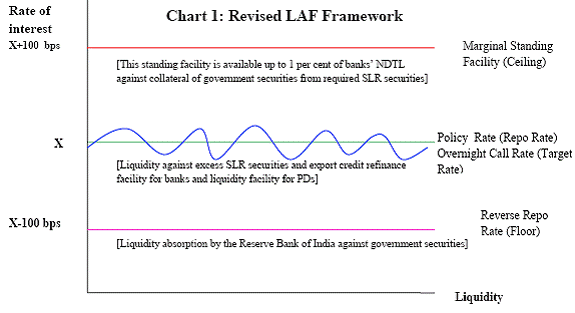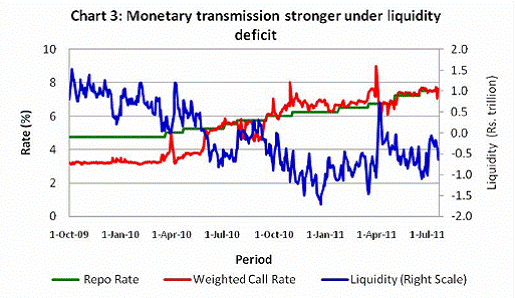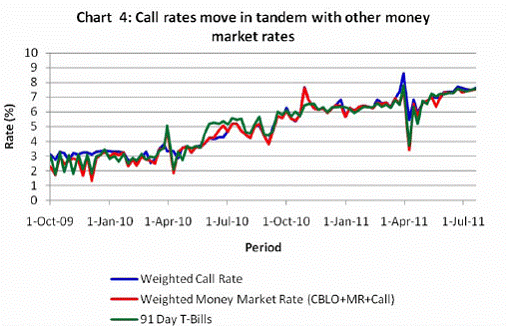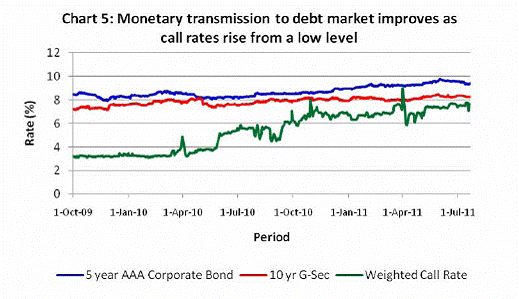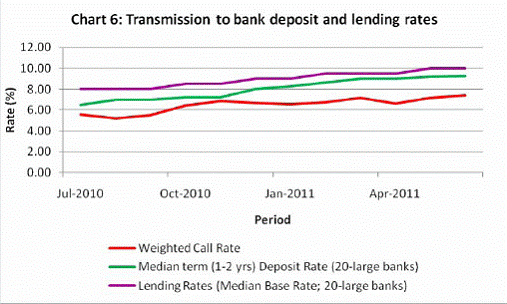 IST,
IST,


How does the Reserve Bank of India Conduct its Monetary Policy?
Shri Deepak Mohanty, Executive Director, Reserve Bank of India
delivered-on ஆக. 12, 2011
I thank the Indian Institute of Management (IIM), Lucknow for inviting me to address this distinguished gathering. I do see many bright young prospective managers in the audience. As you step out of the portals of the Institute, you will be faced with the challenge of managing some or the other key aspect of our economy, be it agriculture, industry or services. This evening, let me give you a flavour of how do we manage monetary policy in the Reserve Bank of India? In central banking parlance this is known as the operating procedure or the implementation of monetary policy. Essentially, it is the day-to-day management of monetary policy in pursuit of ultimate objectives of price stability and growth. In my presentation, I will address the following questions: Why is monetary policy operating procedure important? How do major central banks operate their monetary policy? What is the Reserve Bank’s monetary policy operating framework? How effective is the Reserve Bank’s monetary operating framework? I will conclude by highlighting some challenges in the operations of monetary policy on the way forward. Why is monetary policy operating procedure important? Monetary policy as an arm of public policy has set objectives and priorities. These objectives are derived from the respective mandates of central banks. It ranges from a single objective of price stability, considered to be the dominant objective of monetary policy, to multiple objectives that include growth and financial stability as well. Central banks strive to achieve these objectives indirectly through instruments under their direct control and on the basis of the empirical relationship these instruments have with the final objectives. This requires articulation of a consistent monetary policy framework that enables transmission of policy signals in such a way that monetary and financial conditions are influenced to the desired extent to attain the objectives. Monetary policy framework, however, is a continuously evolving process contingent upon the level of development of financial markets and institutions, and the degree of global integration. As long as the value of money was linked to gold or silver, monetary policy had a secondary role. With the breakdown of the Bretton Woods system of fixed exchange rate, monetary policy framework evolved from that of setting an intermediate target. Under this framework, central banks, through the instruments under their direct control, were trying to influence an intermediate target such as money supply which had a stable relationship with the final objectives of price and output. This framework was abandoned by advanced central banks towards the late 1980s because of the unstable relationship of money with the final objectives attributed to financial innovations. As an alternative, since the late 1980s, many central banks began to adopt inflation targeting framework in which inflation was directly targeted as the sole final objective. The recent global financial crisis has, however, questioned the virtue of this framework, as sole focus on price stability failed to ensure financial stability (Subbarao, 2010).1 Among advanced central banks, while the Bank of England is an inflation targeting central bank, there are many others which follow an eclectic approach. For instance, the US Federal Reserve follows a framework termed as risk management approach wherein a view on interest rate is taken on consideration of balance between risks to inflation and growth. Similarly, the European Central Bank takes policy decisions based on a twin strategy comprising economic and monetary analysis. It is, however, important to note that irrespective of differences in frameworks, price stability, interpreted as low and stable inflation, remains the dominant objective of monetary policy for all these central banks. Once a monetary policy framework is in place, it needs to have a supporting operating procedure through which monetary policy is implemented. An operating procedure is defined as day-to-day management of monetary conditions consistent with the overall stance of monetary policy. Generally, it involves: (i) defining an operational target, generally an interest rate; (ii) setting a policy rate which could influence the operational target; (iii) setting the width of corridor for short-term market interest rates; (iv) conducting liquidity operations to keep the operational target interest rate stable within the corridor; and (v) signalling of policy intentions. In addition, most central banks require commercial banks to keep minimum cash reserves with them. Commercial banks also require cash to meet the currency demand of their clients. The inter-bank transactions are also ultimately settled in their accounts with the central bank. The demand for and supply of cash reserves provide the lever to central banks not only to modulate liquidity in the system but also to set interest rate in the money market. Through the calibration of monetary conditions by using instruments under its direct control, a central bank guides the operating target to the desired level. Under a monetary targeting framework, bank reserves used to be the operating target. Central banks used to influence money supply through varying required reserves. Though cash reserve requirements remain in the toolkit of central banks, they are not actively used by advanced economies as an operating target in normal times. Consequently, most of the central banks now signal their monetary policy stance by setting interest rates in the money market. The operating target, therefore, is one of the short-term market interest rate. The operating target, however, is only an intermediate objective of monetary policy. The ultimate objectives are price stability, growth and financial stability. The effect of interest rate on these ultimate objectives would depend upon how the signals are transmitted through the financial system and how businesses and households respond to these changes. These transmission channels could be commercial interest rates, asset prices, exchange rate and expectations. The main transmission channel, however, is the commercial interest rate channel whereby change in the policy interest rate impacts deposits and lending rates of financial institutions, and alters the spending and investment decisions of households and businesses. The relative importance and effectiveness of each of these four channels of transmission, however, are conditioned by development of financial markets and institutions, and the degree of global integration. How do major central banks operate their monetary policy? I propose to briefly highlight the operating procedures of the US Federal Reserve (Fed), the Bank of England (BoE) and the European Central Bank (ECB). This will facilitate a comparison of the RBI’s operating procedure vis-á-vis the international best practice. Federal Reserve Bank Depository institutions or commercial banks in the US are required to maintain a prescribed minimum reserve at the Fed. The actual reserve balance for a bank, however, keeps fluctuating during a day with continuous receipts and payments taking place. While some banks expect the end-of-day reserve balance to fall short of the minimum required, other banks anticipate a surplus balance. Thus, banks expecting surplus reserve balance at the Fed lend to banks expecting to end with deficit reserve balance. The market in which the lending of Federal Reserve balances takes place is known as the federal funds market. The overnight interest rate at which the loan is made is called federal funds rate. The federal funds rate eventually gets transmitted to other interest rates and impact the economy. Thus, the operating procedure of the Fed is focussed on keeping the federal funds rate at a pre-announced target level. First, based on the outlook of inflation and growth, the target for the federal funds rate is announced by the Federal Open Market Committee (FOMC). Second, the Fed attempts to adjust the total supply of reserve balances so that it exactly equals demand at the target federal funds rate. This adjustment of total supply of reserve balances available to commercial banks is carried out primarily through open market operations (OMO) where government bonds or other securities are exchanged for reserves. The OMO is largely conducted by arranging overnight repurchase (repo) auctions with primary dealers. Besides OMO, credits provided by the Fed to banks at a rate higher than the federal funds rate - called discount rate - play an important role in the implementation of monetary policy. Credits are provided under two programmes, viz., primary credit and secondary credit. Under primary credit, the Fed extends short-term credit to eligible banks at a rate above the target federal funds rate. Since the Fed operates in a systemic liquidity deficit mode, the interest rate on primary credit acts as the upper ceiling for the federal funds rate. Secondary credit is provided only under abnormal circumstances when depository institutions do not qualify for primary credit or for resolution of financial difficulties. Understandably, the interest rate charged for this credit is higher than that for primary credit. As such, there was no lower bound for federal funds rate. However, since December 2008, the Fed has been providing remuneration to all reserves at the rate of 25 basis points. This rate on reserves is expected to act as the lower bound to the federal funds rate. Bank of England Let me first illustrate the normal monetary operating procedure of the BoE which has been suspended since March 2009 following the global financial crisis. Each of the UK banks and building societies, eligible and participating in the reserves-averaging scheme, is required to set its own target of average sterling reserve balances it will hold during a reserve maintenance period.2 The BoE remunerates these reserves holding at the Bank Rate so long as they are, on an average, over the maintenance period, within a small range around the target. Thus, to keep the reserve balances within the target range, banks lend and borrow among themselves in the sterling interbank market. The aim of the BoE is to ensure that the sterling interbank market rates are in line with the Bank Rate by operating at the margin as supplier or taker of funds. The policy rate, i.e., the Bank Rate is set by the Monetary Policy Committee (MPC) based on macroeconomic conditions. Changes in the Bank Rate affect the whole range of interest rates set by commercial banks, building societies and other institutions. Thus, the level of the Bank Rate denotes the stance of monetary policy. To keep the aggregate supply of reserves at the desired level, the BoE undertakes OMO of varying maturities. The short-term repos are conducted at the Bank Rate.3 The BoE also conducts outright OMO to influence liquidity conditions which are unlikely to be reversed quickly. Modulation of reserve supply by the BoE at the aggregate level, however, does not always ensure that the average reserves holding of an individual bank is within the target range. Average reserves outside the target range attract a charge. However, to avoid the charge, two overnight operational standing facilities are made available to banks. One is an overnight collateralised lending facility from which banks, in the event of reserve shortfall, can borrow from the BoE against high quality collateral at a rate higher than the Bank Rate. The other facility is an uncollateralised deposit facility for surplus reserves at a rate below the Bank Rate. Typically, a commercial bank will be unwilling to deal in the inter-bank market on a term worse than the above two facilities. Thus, the two rates act as the ceiling and floor of an interest rate corridor around the rate at which inter-bank dealings take place. Since March 2009, the BoE has been undertaking asset purchases financed through creation of central bank reserves, known as quantitative easing. As a result, supply of reserves is largely determined by asset purchases decision of the BoE, rather than the demand for reserves by banks. Under this potential imbalance in the demand and supply of reserves, continuation with reserve requirement could have resulted in loss of control over market interest rates. Thus, the BoE suspended reserve averaging regime in March 2009. Instead, the BoE currently operates a ‘floor system’ whereby all reserves balances are remunerated at the Bank Rate. Thus, there is no need for the deposit facility for reserve account holders. But, some operating standing facilities participants do not have reserve account with the BoE, meaning the deposit rate still acts as the floor for them. Since March 2009, the deposit rate has been set a zero. The short-term OMOs have also been suspended, as there are no reserve targets currently.4 European Central Bank The key monetary policy instrument of the ECB is a liquidity injection OMO called the Main Refinancing Operation (MRO). The Governing Council of ECB decides the minimum bid rate in the MRO repo auction which is the policy rate. Through the MRO, the ECB guides the overnight inter-bank market rate, viz., euro overnight index average (EONIA) around the minimum bid rate. Further, for the purpose of controlling EONIA, and reducing its volatility, a marginal lending facility and a deposit facility are provided. The two rates in the standing facilities form the upper and the lower bound of the interest rate corridor within which overnight inter-bank rates fluctuate. Besides the above main operation, the ECB conducts OMO for longer term refinancing operations, fine-tuning operations and structural operations. The credit institutions or banks in the euro area are also subject to minimum reserve requirement with the respective national central banks (NCBs). A snapshot of the practice in the Fed, the BoE and the ECB is given in Table below (Table). From this survey of advanced economies, five key features of monetary operations stand out. First, there is a minimum reserve requirement. Second, there is a single policy rate. Third, the objective of the policy rate is to target a short-term money market rate. Fourth, there is a corridor around the policy rate charted by interest rates for standing facilities which aim to contain the volatility in the target interest rate. Fifth, the interest rates on standing facilities are determined with reference to the policy rate. What is the Reserve Bank of India’s operating framework? The monetary policy framework and the associated operating procedure of monetary policy in India have also evolved over time. On 3rd May 2011, the Reserve Bank in its Annual Monetary Policy Statement announced a revised monetary policy operating procedure based on the recommendations of a Committee constituted for the purpose.5 Before I delve into the current operating procedure, let me give you a snapshot of the evolution of our monetary policy operations since the inception of the Reserve Bank of India in 1935. First, in the formative years during 1935-1950, the focus of monetary policy was to regulate the supply of and demand for credit in the economy through the Bank Rate, reserve requirements and OMO. Second, during the development phase during 1951-1970, the need to support plan financing through accommodation of government deficit financing by the RBI began to significantly influence the conduct of monetary policy. This led to introduction of several quantitative control measures to contain the consequent inflationary pressures while ensuring credit to preferred sectors. These measures included selective credit control, credit authorisation scheme (CAS) and ‘social control’ measures to enhance the flow of credit to priority sectors. The Bank Rate was raised more frequently during this period. Third, during 1971-90, the focus of monetary policy was on credit planning. However, the dominance of fiscal policy over monetary policy accentuated and continued through the 1980s. To raise resources for the government from banks, the statutory liquidity ratio (SLR) was progressively increased from the statutory minimum of 25 per cent of banks’ net demand and time liabilities (NDTL) in 1970 to 38.5 per cent by 1990. And to neutralise the inflationary impact of deficit financing, the cash reserve ratio (CRR) was gradually raised from its statutory minimum of 3 per cent to 15 per cent of NDTL during the period. Fourth, the 1980s saw the adoption of monetary targeting framework based on the recommendations of Chakravarty Committee (1985). Under this framework, reserve money was used as operating target and broad money (M3) as an intermediate target. A number of money market instruments such as inter-bank participation certificates (IBPCs), certificates of deposit (CDs) and Commercial Paper (CP) were introduced based on the recommendations of Vaghul Committee (1987). Fifth, structural reforms and financial liberalisation in the 1990s led to a shift in the financing paradigm for the government and commercial sectors with increasingly market-determined interest rates and exchange rate. By the second half of the 1990s, in its liquidity management operations, the RBI was able to move away from direct instruments to indirect market-based instruments. The CRR and SLR were brought down to 9.5 per cent and 25 per cent of NDTL of banks by 1997. Sixth, the monetary policy operating procedure also underwent a change following the recommendation of Narasimham Committee II (1998). The RBI introduced the Interim Liquidity Adjustment Facility (ILAF) in April 1999, under which liquidity injection was done at the Bank Rate and liquidity absorption was through fixed reverse repo rate. The ILAF gradually transited into a full-fledged liquidity adjustment facility (LAF) with periodic modifications based on experience and development of financial markets and the payment system. The LAF was operated through overnight fixed rate repo and reverse repo from November 2004. The LAF helped to develop interest rate as an instrument of monetary transmission. In the process, two major weaknesses came to the fore. First was the lack of a single policy rate. The operating policy rate alternated between repo and reverse repo rates depending upon the prevailing liquidity condition. In a surplus liquidity condition, the operating policy rate was the reverse repo rate, while in a deficit liquidity situation it was the repo rate. Second was the lack of a firm corridor. The effective overnight interest rates dipped below the reverse repo rate in surplus conditions and rose above the repo rate in deficit conditions. Moreover, overnight call rates became unbounded under occasional liquidity stress. Thus, more often the overnight interest rate remained outside the corridor. New Operating Procedure Against this background, the new operating procedure retained the essential features of the LAF framework with the following key modifications. First, the weighted average overnight call money rate was explicitly recognised as the operating target of monetary policy. Second, the repo rate was made the only one independently varying policy rate. Third, a new Marginal Standing Facility (MSF) was instituted under which scheduled commercial banks (SCBs) could borrow overnight at their discretion up to one per cent of their respective NDTL at 100 basis points above the repo rate. Fourth, the revised corridor was defined with a fixed width of 200 basis points. The repo rate was placed in the middle of the corridor, with the reverse repo rate 100 basis points below it and the MSF rate 100 basis points above it. The current operating framework is illustrated in Chart 1.
The new operating procedure improves upon the earlier LAF framework by removing some of the major drawbacks. It is also a move towards international best practices. It is expected that the new procedure will improve the implementation and transmission of monetary policy. First, explicit announcement of an operating target makes it clear to the market participants about the desired policy impact. Second, a single policy rate removes the confusion arising out of policy rate alternating between the repo and the reverse repo rates. It also improves the accuracy of signalling monetary policy stance. Third, the institution of MSF provides a safety valve against unanticipated liquidity shocks. It will help stabilise the overnight interest rate around the repo rate, particularly during deficit liquidity situation. Fourth, a fixed interest rate corridor set by MSF rate and reverse repo rate, by reducing uncertainty and avoiding communication difficulties associated with a variable corridor, will help keep the overnight average call money rate close to the repo rate. How effective is the new operating framework? While it is too early to judge the efficacy of the new operating procedure, experience of over 3 months suggests that overnight interest rate was more stable following the implementation of the new procedure (Chart 2).
The new operating framework with the modified LAF presupposes the dominance of the interest rate channel of monetary transmission. This means that once the RBI changes policy repo rate, it should immediately impact the overnight interest rate which is the operational rate and then transmit through the term structure of interest rates as well as bank lending rates. However, there are challenges. The strength of transmission through the interest rate channel depends on several factors, particularly on liquidity conditions. Recent experience suggests that as long as systemic liquidity was in surplus, the transmission of policy signal was weak. But once systemic liquidity turned into deficit, the response of the overnight call rate to policy rate was stronger (Chart 3).
The next in the sequence of policy transmission is the general money market. Empirical evidence suggests a strong correlation between the weighted average call rate and other money market interest rates. In other words, they move in tandem (Chart 4).
The direction of transmission from the money market interest rate to debt market is the same, but the magnitude depends on several factors including supply and demand of securities, inflation expectations and economic activity. Debt-market interest rates moved in response to changes in the money market interest rates once call money rates rose from low levels (Chart 5).
The transmission to the credit market is much more complex and occurs through the cost channel. Policy rate changes get translated to deposit rates depending on liquidity conditions and credit demand. As the cost of deposits rises alongside money market rates, lending rates respond to policy rate changes with a lag (Chart 6).
It can thus be seen that the strength of transmission of monetary policy depends on the ability of the central bank to keep liquidity in deficit mode. This raises the question: can the Reserve Bank keep the liquidity in the system in a deficit mode at all times? In this regard, monetary developments over the last few years have been instructive. Liquidity is created in the central bank balance sheet by expansion of either net foreign assets (NFA) or net domestic assets (NDA) or both. For emerging market economies (EMEs) like ours, if capital inflows are far in excess of the absorptive capacity of the economy, it creates domestic liquidity beyond the desired level as excess foreign exchange is absorbed by the central bank. It normally takes offsetting action, by reducing NDA in its book, to neutralise the expansionary effect of foreign currency assets. This operation is known as sterilisation.
It can be seen from Chart 7 that during 2006-07 and 2007-08, NFA of the RBI increased sharply following strong capital inflows. Hence, the RBI had to resort to sterilisation by reducing NDA to contain liquidity, i.e., reserve money. In contrast, in 2009-10 when there was foreign exchange outflow following the global financial crisis, the RBI had to expand NDA to maintain an adequate level of rupee liquidity. The year 2010-11 provides a more balanced picture with a mix of NFA and NDA contributing to desired liquidity expansion. Hence, in a normal situation it may not be very difficult to keep liquidity in a deficit mode. In the case of excessive capital inflows it could still be feasible to keep the system in liquidity deficit mode. If surplus capital inflows are taken into balance sheet of the RBI, other instruments such as market stabilisation scheme (MSS)6 bonds and cash reserve ratio (CRR) could be utilised to bring the system into deficit mode. However, occasionally it may not be possible to bring the system into deficit mode despite deployment of all instruments as was seen during 2006-08. In recognition of the fact that monetary transmission will be better if the liquidity in the system is in deficit, the Reserve Bank’s position on liquidity as articulated in the recent monetary policy statements aims to “.... manage liquidity to ensure that monetary transmission remains effective, without exerting undue stress on the financial system”. 7 Challenges on the way forward! The new operating procedure of monetary policy has been drawn up in order to remove the drawbacks experienced in the earlier LAF framework and it is consistent with the international best practices. The announcement of an explicit operating target, institution of an independently varying single policy rate and an interest rate corridor set by MSF and reverse repo will all improve the implementation of monetary policy in India. At the same time, there are three main challenges going forward, which need to be recognised. One, international best practices and our own empirical evidence suggest that the transmission of policy signals to the operating target and other short-term market interest rates is most effective under deficit liquidity conditions. The challenge is to keep the systemic liquidity in a deficit mode consistently. This needs an accurate forecasting of liquidity. But several autonomous factors limit the ability of the RBI and market participants to forecast liquidity. Foremost among these factors is the uncertainty arising out of government cash balances and unanticipated swings in capital flow. We need to put in place a system which can reasonably forecast the changes in these autonomous determinants of liquidity, so that commensurate action can be taken. Two, even if uncertainties of sudden swings in liquidity are not there, there could be prolonged phases of autonomous liquidity infusion due to sustained capital inflows or liquidity drain due to persistent surplus of government cash balances. The challenge in this case, however, is in having the capacity to conduct longer term liquidity management operation through instruments such as long-term and outright OMO, MSS and CRR. It is a challenge because the success of these instruments is circumscribed by market appetite. These instruments also need to be augmented by a scheme of auction of government cash balances. Three, effective transmission of policy signals to the operating target, while necessary, is not a sufficient condition for the success of monetary policy. Needless to say, the success lies in the achievement of the ultimate objective of sustained growth with price and financial stability. This entails improved transmission of short-term interest rates to other long-term commercial interest rates. This will require further deepening of financial markets and removal of structural rigidities coming in the way of market determination of interest rates. * Speech by Shri Deepak Mohanty, Executive Director, Reserve Bank of India, delivered at the Indian Institute of Management (IIM), Lucknow on 12th August 2011. The assistance provided by Shri Jeevan Khundrakpam is acknowledged. 1 Subbarao, Duvvuri (2010), “Financial Crisis – Some Old Questions and May be Some New Answers”, Tenth C.D. Deshmukh Memorial Lecture delivered at the Council for Social Development, Southern Regional Centre, Hyderabad on August 5, 2010. 2 Following quantitative easing by way of large-scale asset purchases through creation of central bank reserves, BOE has suspended the reserves averaging scheme since March 2009. 3 With the suspension of reserves averaging scheme, short-term OMO has also been suspended since March 2009. 4 Bank of England (2010), “The Framework of the Bank of England’s Operations in the Sterling Money Markets, Updated, December. 5 Report of the Working Group on Operating Procedure of Monetary Policy (Chairman: Deepak Mohanty) http://www.rbi.org.in/scripts/BS_PressReleaseDisplay.aspx?prid=24063 6 MSS-bonds are short- to medium-term government bonds used for sterilisation purposes. The proceeds of these bonds remain impounded in the RBI balance sheet. 7 First Quarter Review of Monetary Policy 2011-12, July 26, 2011. |
கடைசியாக புதுப்பிக்கப்பட்ட பக்கம்:






